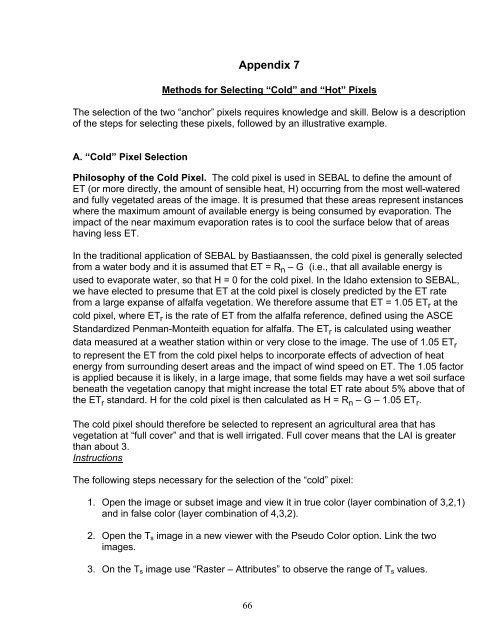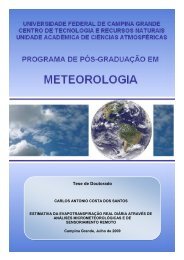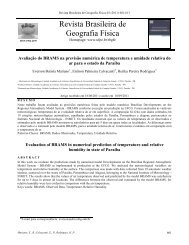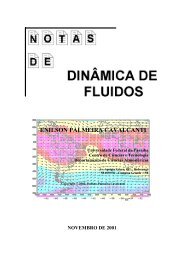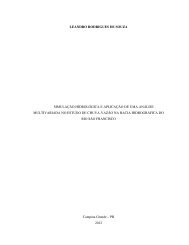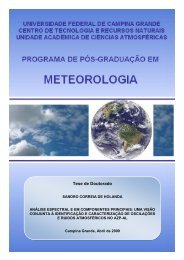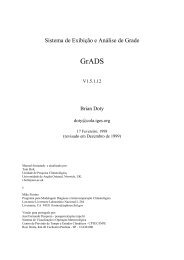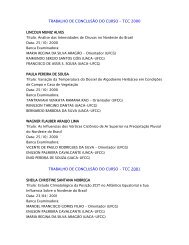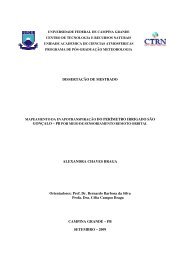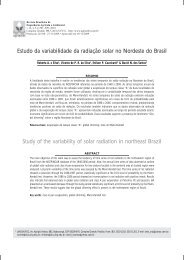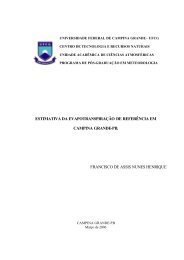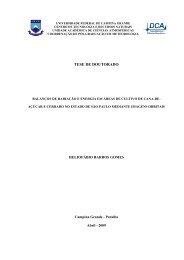Create successful ePaper yourself
Turn your PDF publications into a flip-book with our unique Google optimized e-Paper software.
Appendix 7Methods for Selecting “Cold” and “Hot” PixelsThe selection of the two “anchor” pixels requires knowledge and skill. Below is a descriptionof the steps for selecting these pixels, followed by an illustrative example.A. “Cold” Pixel SelectionPhilosophy of the Cold Pixel. The cold pixel is used in <strong>SEBAL</strong> to define the amount ofET (or more directly, the amount of sensible heat, H) occurring from the most well-wateredand fully vegetated areas of the image. It is presumed that these areas represent instanceswhere the maximum amount of available energy is being consumed by evaporation. Theimpact of the near maximum evaporation rates is to cool the surface below that of areashaving less ET.In the traditional application of <strong>SEBAL</strong> by Bastiaanssen, the cold pixel is generally selectedfrom a water body and it is assumed that ET = R n – G (i.e., that all available energy isused to evaporate water, so that H = 0 for the cold pixel. In the Idaho extension to <strong>SEBAL</strong>,we have elected to presume that ET at the cold pixel is closely predicted by the ET ratefrom a large expanse of alfalfa vegetation. We therefore assume that ET = 1.05 ET r at thecold pixel, where ET r is the rate of ET from the alfalfa reference, defined using the ASCEStandardized Penman-Monteith equation for alfalfa. The ET r is calculated using weatherdata measured at a weather station within or very close to the image. The use of 1.05 ET rto represent the ET from the cold pixel helps to incorporate effects of advection of heatenergy from surrounding desert areas and the impact of wind speed on ET. The 1.05 factoris applied because it is likely, in a large image, that some fields may have a wet soil surfacebeneath the vegetation canopy that might increase the total ET rate about 5% above that ofthe ET r standard. H for the cold pixel is then calculated as H = R n – G – 1.05 ET r .The cold pixel should therefore be selected to represent an agricultural area that hasvegetation at “full cover” and that is well irrigated. Full cover means that the LAI is greaterthan about 3.InstructionsThe following steps necessary for the selection of the “cold” pixel:1. Open the image or subset image and view it in true color (layer combination of 3,2,1)and in false color (layer combination of 4,3,2).2. Open the T s image in a new viewer with the Pseudo Color option. Link the twoimages.3. On the T s image use “Raster – Attributes” to observe the range of T s values.66


